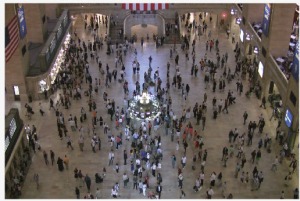Understanding Collective Crowd Behavior: A Computer Vision Approach
Recently I publish a research paper at IEEE Conference on Computer Vision and Pattern Recognition (CVPR) 2012, to analyze the collective crowd behavior in New York Grand Central Station. Here is the paper and project page.

Grand Central Station
Generally speaking, the objective of this project is to learn the collective crowd behavior patterns from the real video of New York Grand Central Station. And the learned collective behavior patterns are used in a lot of important applications, such as crowd simulation, collective behavior classification, and abnormality detection.
Though there are quite a lot of pedestrian walking in the station at one time(~400 population) which form a variety of collective crowd behaviors, one key fact is that instead of randomly moving, majority of these pedestrian have clear belief of the destination to reach in mind, i.e., entering from one entry and walking to one exit in other side of the station. Thus, the overall behavior of one pedestrian in the station will be largely influenced by his belief of starting point and destination, along with two other properties: his preference of movement dynamics and timing of emerging (the frequency of entering the scene from the starting point).
Following this intuitive analysis, from agent-based modeling of the crowd in station, every pedestrian is driven by one type of agents with three properties: the belief of starting point and destination, movement dynamics, and the timing of emerging. And the whole crowd is modeled as a mixture of pedestrian-agents with different three properties.
For the computational modeling of the pedestrian-agents, please refer to project page and paper for detailed information. Welcome to contact me if you have any questions or suggestions. The original video of the train station and the trajectories used in my paper could be downloaded at here.


Hey Bolei, nice to find this blog here. Your research interest is much similar to what i am working on towards my phd. Nice blog posting on the summary.
I am quite interested in your recent published work on the collective pattern analysis from crowd. I would like to know more abut it, or we can discuss through email.
thank you 🙂
Hi Hu, glad to hear you find this blog helpful. Feel free to discuss with me about the research, and I could help you post your ideas or essay about your research to this blog:)
This work of predicting and clustering the trajectories is cool. We are currently conducting a feasibility study on the tools available for crowd analysis from videos. I think this work is quite relevant. Can you share the code of this work?
One more request 🙂 In your presentation slides for the conference, there was a video demo to compare with the real crowd and trajectories and your simulation side-by-side, but I didn’t find the link there for the video. Can you upload this video as well? Thanks a lot and appreciate this work again